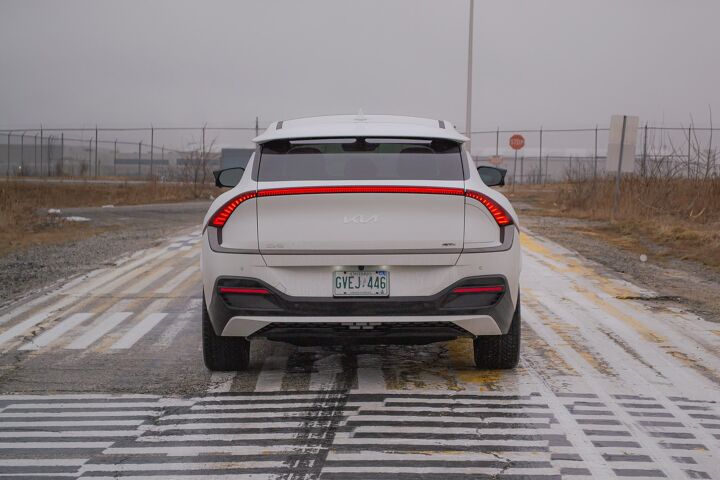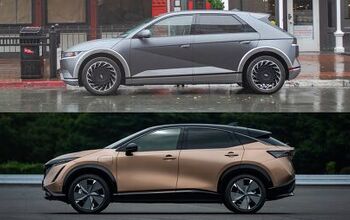Nissan Ariya Vs Kia EV6: Which EV SUV is Right for You?

The competition in the compact EV SUV class is growing at a rapid pace. Here, we take an in-depth look at the Nissan Ariya vs Kia EV6.
The Ariya is a long-awaited launch from Nissan, finally about to hit the roads this year. It promises to be the next stage of EV development for the company, and a glimpse into the new design language for future Nissan products.
Get a Quote on a New Nissan Ariya vs Kia EV6Kia’s sporty EV crossover has already been making waves over its bold exterior design, alongside its retro-futuristic cousin from Hyundai. Both the Nissan and Kia offer a range of powertrain options matched to smart interiors packed with tech. To see if the Ariya can take away some of the EV6’s momentum, we are looking at each vehicle’s features and capabilities side-by-side. Read on to see which EV SUV is better for you.
Style

Nissan Ariya: Nissan is betting big on style with the Ariya, taking major inspiration from Japanese design philosophies. At launch, it will be available in 6 two-tone and 3 full-body colors. The shield front grille features a 3D Kumiko pattern and wears the redesigned brand logo. It echoes at the back by the single piece “light blade”. A set of 19-inch wheels are standard while 20-inch wheels are optional on higher trims.
The company describes the interior as a “sleek cafe lounge on a starship”. We’ll leave you to decide if that comparison is appropriate. Regardless of the description, the Ariya features a fuss-less cabin built around a dual-screen display. It puts heavy emphasis on horizontal design elements while downplaying tactile buttons and switches on the dashboard.

Kia EV6: The sleek, sporty cousin to the Ioniq 5, the EV6 offers a slick alternative to most conventionally-design EVs on the market. The distinctive high tail with integrated lighting stretching across the entire width of the vehicle is a feature you’d recognize from a mile away. A diamond stud texture is strewn across the exterior and also found across the Kia range.
SEE ALSO: 2022 Kia EV6 Review: Futuristic Family MachineOn the inside, two things immediately stand out at first glance. A hollow center console makes use of the flat floor and provides storage with charging on the bottom. It also provides a platform for gear selection and other controls on top. The instrument cluster and infotainment screen are combined into one single dual-screen unit stretching across the dashboard. Various combinations of suede, synthetic leather, and recycled fabric come together to create a contemporary environment.
Bottom Line: Stylewise, the Nissan Ariya and Kia EV6 are close competitors. Both offer swoopy, futuristic exteriors, with lounge-like interiors utilizing the available flat floor configuration. The Ariya does lean slightly toward luxury while the EV6 is a bit sportier. So, it’s a toss up to be decided by personal preference.
Cabin Space

Nissan Ariya: Nissan has yet to release the official numbers for interior space, but we can speculate a bit on what the seating situation might feel like. The flat floor creates an airy environment that maximizes utility inside the cabin. The swoopy roofline towards the rear though may reduce some of the headroom for back seat passengers.

Kia EV6: The EV6 without a sunroof equipped grants up to 39 inches (991 mm) of headroom for the front row, or a reduced 36.8 inches (935 mm) with one. Back row headroom is 38 inches (965 mm) regardless of equipment chosen. Front passengers also get 42.4 inches (1077 mm) of legroom, 57.8 inches (1468 mm) of shoulder room, and 54.9 inches (1394 mm) of hip room. In the back, there are 39 inches (991 mm) of legroom, 55.6 inches (1412 mm) of shoulder room, and 53.2 inches (1351 mm) of hip room.
Bottom Line: While not completely indicative of interior dimensions, the EV6 is a longer and wider car on the outside. The Ariya counters by having the height advantage. We’ll have to wait until the official numbers from Nissan are released to make a proper comparison.
Nissan Ariya vs Kia EV6: Powertrains

Nissan Ariya: The Ariya has a range of battery and motor configurations available, with additional options to be released in the future. For now, the single motor setup puts out 238 hp and 221 lb-ft of torque and drives the front wheels. The dual motor e-4ORCE all-wheel drive option is rated for 389 hp and 442 lb-ft of torque. A singular 87 kWh battery is offered from the start. A smaller 63 kWh battery will be available in the future on entry level trims.
SEE ALSO: 2023 Nissan Ariya Hands-On Preview: 5 Things We Learned About Nissan’s Next EV
Kia EV6: EV6s can come with either a 58.0 kWh short range battery pack, or a larger 77.4 kWh long range battery. Single motor configurations drive just the rear wheels, making 167 hp with the smaller battery or 225 hp with the long range battery. All rear-wheel drive models put out 225 lb-ft of torque. The dual motor EV6 gets a claimed 320 hp and 446 lb-ft of torque.
Bottom Line: Nissan offers bigger battery packs and more powerful motors throughout the Ariya range than the equivalent EV6. How this translate to real world performance we’ll have to wait and see once we get a chance to drive the Ariya.
Efficiency and Range

Nissan Ariya: For the best EV range, you should be looking at the Ariya Venture+. It offers a claimed range of 304 miles (489 km) on a single charge. Trims like the Platinum+, featuring dual motors and all-wheel drive, have a reduced range of 265 miles (426 km). Official EV efficiency figures have yet to be released.

Kia EV6: Like the Ariya, Kia offers up a slew of drive and battery choices. The smaller 58.0 kWh battery powering just the rear wheels can get up to 232 miles (373 km) of range. The larger 77.4 kWh battery also with rear-wheel drive is rated for 310 miles (499 km). Single motor EV6s get a rated 136 / 100 / 117 MPGe (1.7/2.4/2.0 Le/100 km) for city, highway, and combined. Dual motor cars are rated for 116 / 94 / 105 MPGe (2.0/2.5/2.2 Le/100 km) for city, highway, and combined, respectively.
Bottom Line: We can’t quite compare the EV economy numbers just yet. But the Ariya and EV6 both offer a similar choice of available EV ranges based on their respective motor and battery configurations. The longest range EV6 barely ekes out a win over the Ariya on paper. We’ll have to see how the figures stack up once Nissan starts offering the smaller, entry-level battery pack.
Cargo and Towing

Nissan Ariya: Storage is limited to the space behind the rear seats as the Ariya is without a frunk. Front-wheel drive models allow for 16.5 cubic feet (467 L). All-wheel drive versions though get slightly less with 14.6 cubic feet (413 L). It’s possible to fold down the rear seats for additional cargo space, but official figures have not yet been released.

Kia EV6: In the Kia, you get up to 24.4 cubic feet (691 L) of storage behind the second row. Folding down the rear seats more than doubles that space to 50.2 cubic feet (1422 L). Unlike the Ariya, the EV6 does feature a frunk. Although, it’s just a tiny one at 1.8 cubic feet (52 L).
SEE ALSO: Kia EV6 vs Hyundai Ioniq 5 Comparison: Sibling RivalryBottom Line: Until the first Ariyas start hitting the roads and confirmed figures for storage are released, the EV6 seems to have the Nissan beat by a significant amount.
Nissan Ariya vs Kia EV6: Safety

Nissan Ariya: Nissan gives the Ariya a solid package of safety and assistive technology as part of the Safety Shield 360 suite. Automatic Emergency Braking with Pedestrian Detection, High Beam Assist, Lane Departure Warning, Blind Spot Warning, Rear Cross Traffic Alert, Rear Automatic Braking are all standard. The Ariya also adds Intelligent Forward Collision Warning, Intelligent Lane Intervention, Intelligent Blind Spot Intervention, Intelligent Cruise Control, Distance Control, and ProPILOT Assist with Navi-Link. Higher trim levels include additional airbags, ProPILOT Assist 2.0, and ProPILOT Park for semi-autonomous driving and parking.

Kia EV6: All EV6s are equipped with passive and assistive safety technologies. For starters, there’s Forward Collision Assist for cars, cyclists, and pedestrians. Also included are Blind Spot Assist, Rear Cross Traffic, Lane Keeping, Lane Following, Smart Cruise Control, Highway Driving Assist, and Parking Distance Warning. Going up to the more premium trims also unlocks Blind Spot View Monitor, Smart Cruise with Machine Learning, Surround View, and Smart Parking Assist.
Bottom Line: Both cars offer a ton of practical safety technology, even on the basic trim levels. Pony up for the premium versions will get you more autonomous features. Honestly, you can’t really go wrong with either one.
Tech and Features

Nissan Ariya: Nissan’s dual 12.3 inch screen setup in the Ariya allows for seamless swiping of information from screen to screen. Wireless Apple CarPlay and Android Auto comes with every Ariya, pumping out the tunes through a 6-speaker system as standard. Both the Evolve+ and Platinum+ trims offer a moonroof, power-adjustable seats in the front, front and rear heated seats, seat memory, heated steering wheel, a color heads-up display, and wireless device charging. The top-of-the-line Platinum+ also offers cooled seats for the front row and a 10-speaker Bose audio system. Firmware updates are sent Over-The-Air on all Ariyas.
SEE ALSO: Nissan Ariya EV Crossover Plans To Be The First To Drive From North Pole To South Pole
Kia EV6: Also rocking a similar dual 12.3 inch screen setup, the EV6 includes a ton of standard equipment and technology. On all EV6s there’s Apple CarPlay/Android Auto, a WiFi hotspot, wireless device charging, automatic climate control, power-adjustable driver seat, heated seating for the front, and seat memory. Upgrading to the Wind trim nets a 14-speaker Meridian audio system, power-adjustable and ventilated seating for the front passenger, and a power liftgate. The GT-Line also adds an augmented reality heads up display and a wide power sunroof.
Bottom Line: For the price, there’s more everyday equipment and tech in the Kia than the Nissan. Front seat heating, power-adjustability, and memory, as well as wireless phone charging all come as standard with the EV6. Upgrading to the mid-range trims also includes four more speakers in the Kia.
Pricing

Nissan Ariya: At launch, the Ariya is available in four trims. The Venture+, priced from $47,125 (including $1,175 destination) will be the entry point for the model range. Later, the Engage trim will become available as the new base model. The mid range Evolve+ is priced at $50,125, while the range topping Platinum+ will set you back $60,125. A launch-exclusive Premiere trim slots in between the Evolve+ and Platinum+ at $54,625.

Kia EV6: For its first year in production, the EV6 comes in three discrete trims. The thriftiest way to get into an EV6 is with the Light trim and its 58.0 kWh battery plus rear-wheel drive. It’s priced from $42,695 (including $1,295 destination). Mid-range Wind models come in either rear-wheel or all-wheel drive, priced at $48,795 and $52,115. The GT-Line in rear-wheel drive configuration is $52,995, while the all-wheel drive version starts from $57,115.
Bottom Line: Until the full Ariya lineup becomes available, the EV6 holds the distinction of having the more affordable price point. There’s more standard equipment from the Kia throughout the middle of the price range. At the top end of the spectrum, the Ariya Platinum+ with its 389 horses and all-wheel drive comes in at a few thousand less than the equivalent offering from Kia.
Nissan Ariya vs Kia EV6: In Conclusion

The upcoming Ariya poses a new, stylish contender for the midsize EV crossover segment. But the EV6 doesn’t exactly disappear into the crowd with its design. Both models offer bundles of technology, with comfortable interiors, and an array of battery and motor options.
We expect the EV6 to offer sharper driving dynamics and for the Ariya to make up for it with power and comfort. The Kia may offer more practical cargo space over the Nissan and start at a lower price right for now. But a fully-equipped Ariya comes in less than the equivalent EV6. It’s a close matchup, and one that we’re definitely looking forward to comparing on the roads soon.
Become an AutoGuide insider. Get the latest from the automotive world first by subscribing to our newsletter here.
More by Harry Zhou































Comments
Join the conversation
For me, the answer is NEITHER